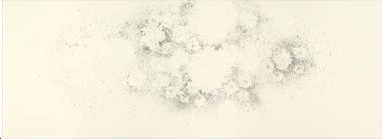Ernesto Caivano
04 Jul - 30 Aug 2008
ERNESTO CAIVANO
"Echo Gambit"
Echo Gambitis the first major solo exhibition in London by the New York based artist Ernesto Caivano.
‘After the Woods’ is an epic narrative set in an alternative universe. Taking the act of consummation as its point of departure, two tragic lovers are separated and transported into a wooded realm, to live a parallel destiny. Situated within polar hemispheres, Versus (the Knight) and Polygon (the Princess) attempt to communicate to each other with the help of their natural habitat, particularly the exotic birds or ‘Philapores’. This romantic, yet doomed allegory echoes the Garden of Eden and the Bible’s Creation story, particularly in the lovers’ final demise following a gambit taken in order to secure their offspring and thereby return to the origin of the story in the previous millennium.
As Caivano explains, "The ‘echo gambit’ is about the relationship between people and nature. If, in this dichotomy, one thinks of Frankenstein, then the echo gambit in many ways is the echo that we are creating on the world, similar to the pastiched monster. The gambit is the necessary, but questioned sacrifice - a reconciliation of sorts of the body and spirit, a disintegration of the two”.
Three series of drawings dominated the show: the ‘Echo’ drawings are identifiable from the ‘big bang’ theory to the release of mere pollen or dust particles from the ‘Philapores’ wings. In the ‘Gambit’ series, shards of entropic debris combust from the crown of a tree stump and disperse into the atmosphere. Long beams of prismatic ‘Chroma Transmissions’ radiate coded messages between the lovers. Selections of small studies illustrate isolated elements from the story including extinct species of flora or elaborate plumage of the ’Philapores’. As with all of Caivano’s drawings there is a precision of line, formal beauty and detailed rendering that correlates with the naturalism of Albrecht Dürer’s drawings and the illustrations of Aubrey Beardsley.
By absorbing numerous references from archaic folklore, medieval fairytales, Renaissance literature, fractal geometry or more contemporary discoveries in nanotechnology, ecology and the greater cosmos, Caivano creates a metaphor of human progress. His installation of over seventy drawings and paintings is not presented according to series or scale, but positioned to surround the viewer, like a control room or hub to Caivano’s Odyssey.
A fully illustrated catalogue with essays by Tom Morton and João Ribas was published to accompany the exhibition.
Ernesto Caivano was born in Madrid (1972) and currently lives and works in New York. He studied at The Cooper Union and Columbia University in New York. Selected recent shows include the Whitney Biennial, New York (2004) PS1, New York (2004), ’Games for a Blackout Machine’, Guild and Greyshkul, New York (2006), ‘Floral Veins’, Richard Heller Gallery, Santa Monica (2006) and ‘Traps, Screens and Offerings’, Carlier Gebauer, Berlin (2006).
"Echo Gambit"
Echo Gambitis the first major solo exhibition in London by the New York based artist Ernesto Caivano.
‘After the Woods’ is an epic narrative set in an alternative universe. Taking the act of consummation as its point of departure, two tragic lovers are separated and transported into a wooded realm, to live a parallel destiny. Situated within polar hemispheres, Versus (the Knight) and Polygon (the Princess) attempt to communicate to each other with the help of their natural habitat, particularly the exotic birds or ‘Philapores’. This romantic, yet doomed allegory echoes the Garden of Eden and the Bible’s Creation story, particularly in the lovers’ final demise following a gambit taken in order to secure their offspring and thereby return to the origin of the story in the previous millennium.
As Caivano explains, "The ‘echo gambit’ is about the relationship between people and nature. If, in this dichotomy, one thinks of Frankenstein, then the echo gambit in many ways is the echo that we are creating on the world, similar to the pastiched monster. The gambit is the necessary, but questioned sacrifice - a reconciliation of sorts of the body and spirit, a disintegration of the two”.
Three series of drawings dominated the show: the ‘Echo’ drawings are identifiable from the ‘big bang’ theory to the release of mere pollen or dust particles from the ‘Philapores’ wings. In the ‘Gambit’ series, shards of entropic debris combust from the crown of a tree stump and disperse into the atmosphere. Long beams of prismatic ‘Chroma Transmissions’ radiate coded messages between the lovers. Selections of small studies illustrate isolated elements from the story including extinct species of flora or elaborate plumage of the ’Philapores’. As with all of Caivano’s drawings there is a precision of line, formal beauty and detailed rendering that correlates with the naturalism of Albrecht Dürer’s drawings and the illustrations of Aubrey Beardsley.
By absorbing numerous references from archaic folklore, medieval fairytales, Renaissance literature, fractal geometry or more contemporary discoveries in nanotechnology, ecology and the greater cosmos, Caivano creates a metaphor of human progress. His installation of over seventy drawings and paintings is not presented according to series or scale, but positioned to surround the viewer, like a control room or hub to Caivano’s Odyssey.
A fully illustrated catalogue with essays by Tom Morton and João Ribas was published to accompany the exhibition.
Ernesto Caivano was born in Madrid (1972) and currently lives and works in New York. He studied at The Cooper Union and Columbia University in New York. Selected recent shows include the Whitney Biennial, New York (2004) PS1, New York (2004), ’Games for a Blackout Machine’, Guild and Greyshkul, New York (2006), ‘Floral Veins’, Richard Heller Gallery, Santa Monica (2006) and ‘Traps, Screens and Offerings’, Carlier Gebauer, Berlin (2006).

